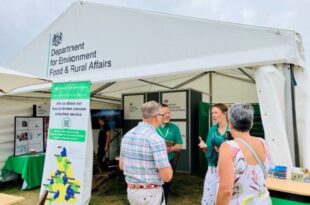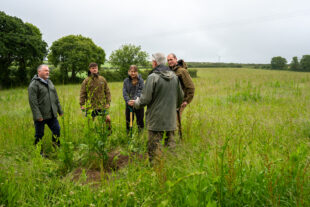https://defrafarming.blog.gov.uk/manage-grazing-on-improved-grassland/
Manage grazing on improved grassland
The guidance on this page is for SFI pilot participants only. Please visit GOV.UK for the official Sustainable Farming Incentive scheme guidance.
Find out how land managers can reduce inputs of fertiliser and manure, improve soil health and benefit wildlife by using pasture efficiently.
If you’re completing this action as part of the Sustainable Farming Incentive pilot, how you do it is up to you.
The advice on this page can help you get better environmental and business benefits, but you do not have to follow it to get paid.
About improved grassland
Improved grassland occurs on a wide range of soils. It can be re-seeded every few years, but it can be longer-term permanent grassland. You’ll usually use regular nitrogen inputs like manufactured fertiliser, animal manure or slurry.
Rye-grasses and white clover often dominate the sward. Other sown grasses may include cock’s-foot and timothy.
You may have sown clover to replace the use of fertiliser, but it does occur naturally in some swards. Clover uses a chemical process known as fixing to change nitrogen in the air into nitrogen compounds in soil.
More established swards may have:
- additional grasses, like bents, fescues and Yorkshire fog
- some wildflowers, like creeping buttercup and dandelion
Where to manage grazing on improved grassland
You can manage grazing of improved grassland on:
- beef, sheep or dairy farms
- mixed livestock and arable farms
Permanent grassland will provide greater benefits for wildlife, especially where you:
You’ll attract more wildlife if you maintain longer swards alongside other grassland and semi-natural habitats. These include:
- grass margins and field corners with tall grass and scrub
- areas with rye-grass left to set seed for winter bird food
- hedgerows, used by yellowhammers and other buntings
- woodland
Benefits of managing grazing on improved grassland
Manage improved grassland to produce diverse swards with varied height (structure). This will:
- let more plants flower to provide food for pollinators
- provide food, like insects and seeds, for birds
- provide shelter for invertebrates
You’ll save money by reducing the amount of animal feed and fertilisers you’ll need. This will help reduce pollution from:
- runoff into water or habitats on land
- ammonia into the air
Less intensive grazing reduces soil compaction and increases plant root depth. This will improve soil fertility and structure, and overall soil health.
It will also:
- improve invertebrate species diversity
- allow plants to flower and set seed
- increase food for farmland birds, like skylarks, starlings and yellowhammers
How to manage grazing on improved grassland
Plan and manage grazing across your farm to make best use of your grass crop and minimise the use of fertiliser.
To maintain grazing and pasture quality, start grazing when the sward height averages 8cm to 12cm. Keep an average sward height of at least 5cm while growing. If you graze grass too short it will reduce its growth.
You can use different grazing systems, like continuous or rotational grazing. Adapt grazing throughout the year in response to grass growth.
Graze with cattle, or a mixture of cattle and other livestock, to achieve a range of sward heights. Cattle are best if you want to create a range of grass heights.
Lenient grazing
Lenient grazing uses less livestock or rest periods to reduce grazing intensity.
To get the most benefits for wildlife, you should graze lightly in spring. Leave a longer sward in summer. Repeat this for at least 3 years to develop sward structure and invertebrate populations.
Aim for an average sward height of at least 8cm throughout the grazing season, and with:
- at least 20% over 10cm tall, to provide invertebrate habitat and let plants flower and set seed
- at least 20% shorter than 10cm, so birds can find food
During winter let livestock graze the sward down to less than 7cm to avoid it becoming too tall and coarse (rank).
Do not cut or top swards, unless you need to stop the spread of weeds. Cutting will reduce structural diversity.
Measure sward height and grass availability
Measure the height of the pasture to work out the amount of grass available. Use this to decide the number of livestock to graze.
- Walk each field in a ‘W’ pattern and measure at least 30 sward heights along the ‘W’, making sure you do not flatten the grass.
- Measure to the top green leaf but ignore stems and seedheads.
- Use the measurements to calculate the average height and range of heights.
Aim to measure the grass height every 2 weeks during the grazing season.
You can measure using a sward stick, a ruler or lines on wellies. You can also use devices such as plate meters. These will give more accurate measures of grass availability.
Check if you can get funding for new sward measurement equipment.
For information on measuring sward height and grass yield read the Agriculture and Horticulture Development Board (AHDB) grazing guide.
How to tell if managed grazing is working
You’ll see:
- different sward heights, providing food and shelter for a range of wildlife
- more species of grasses and wildflowers
- pollinating insects like bees, butterflies and hoverflies
- a dense and competitive sward with few weeds
You’ll reduce use of:
- agricultural inputs, like fertilisers, herbicides and pesticides
- bought feed and supplements
To check for improvements in soil health:



